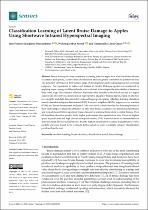| dc.contributor.author | Nturambirwe, Jean Frederic Isingizwe | |
| dc.contributor.author | Perold, Willem Jacobus | |
| dc.contributor.author | Opara, Umezuruike Linus | |
| dc.date.accessioned | 2022-09-14T10:31:04Z | |
| dc.date.available | 2022-09-14T10:31:04Z | |
| dc.date.issued | 2021 | |
| dc.identifier.citation | Nturambirwe JFI, Perold WJ, Opara UL. Classification Learning of Latent Bruise Damage to Apples Using Shortwave Infrared Hyperspectral Imaging. Sensors (Basel). 2021 Jul 22;21(15):4990. doi: 10.3390/s21154990. PMID: 34372227; PMCID: PMC8348186. | en_US |
| dc.identifier.uri | https://doi.org/10.3390/s21154990 | |
| dc.identifier.uri | http://hdl.handle.net/10566/7892 | |
| dc.description.abstract | Bruise damage is a very commonly occurring defect in apple fruit which facilitates disease occurrence and spread, leads to fruit deterioration and can greatly contribute to postharvest loss. The detection of bruises at their earliest stage of development can be advantageous for screening purposes. An experiment to induce soft bruises in Golden Delicious apples was conducted by applying impact energy at different levels, which allowed to investigate the detectability of bruises at their latent stage. The existence of bruises that were rather invisible to the naked eye and to a digital camera was proven by reconstruction of hyperspectral images of bruised apples, based on effective wavelengths and data dimensionality reduced hyperspectrograms. Machine learning classifiers, namely ensemble subspace discriminant (ESD), k-nearest neighbors (KNN), support vector machine (SVM) and linear discriminant analysis (LDA) were used to build models for detecting bruises at their latent stage, to study the influence of time after bruise occurrence on detection performance and to model quantitative aspects of bruises (severity), spanning from latent to visible bruises. Over all classifiers, detection models had a higher performance than quantitative ones. Given its highest speed in prediction and high classification performance, SVM was rated most recommendable for detection tasks. However, ESD models had the highest classification accuracy in quantitative (>85%) models and were found to be relatively better suited for such a multiple category classification problem than the rest. | en_US |
| dc.language.iso | en | en_US |
| dc.publisher | MDPI | en_US |
| dc.subject | Machine learning | en_US |
| dc.subject | Bruise detection | en_US |
| dc.subject | Classification model | en_US |
| dc.subject | Latent damage | en_US |
| dc.title | Classification learning of latent bruise damage to apples using shortwave infrared hyperspectral imaging | en_US |
| dc.type | Article | en_US |

